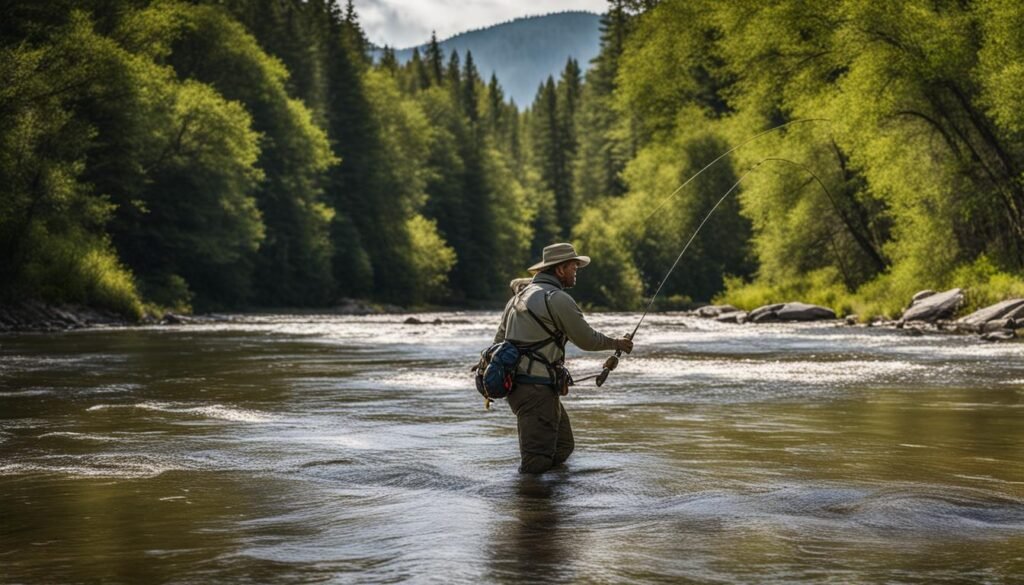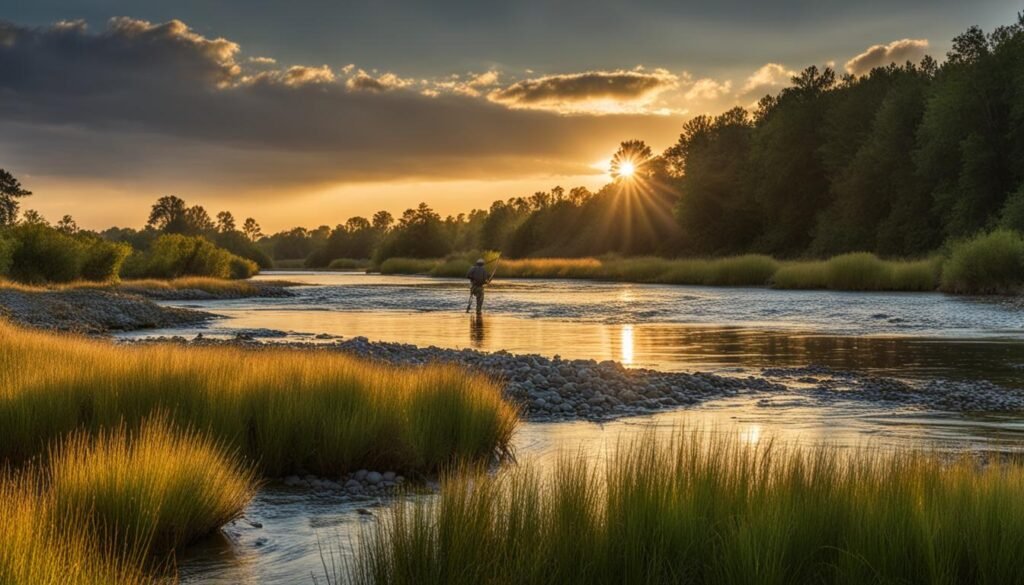Czech nymphing is a highly effective fishing technique that originated in Europe and has gained popularity worldwide. In this guide, we’ll explore what Czech nymphing is, its history, where and when to use it, the specific technique involved, the flies used, and the equipment you’ll need for success.
But before we dive in, take a moment to appreciate the beauty of fly fishing with this stunning image:
Key Takeaways:
- Czech nymphing is a specialized fishing technique that involves fishing nymphs close to the riverbed.
- It’s most effective in moving water, particularly in seams and pockets created by the currents.
- The Czech nymphing method requires short-distance casting and maintaining a taut line to detect strikes.
- Specific nymph flies, such as Bobeshes, are used to imitate underwater insects that fish feed on.
- To practice Czech nymphing, you’ll need a suitable fly rod, reel, leader, and fly tying materials.
What is Czech Nymphing?
Czech nymphing is a specialized fly fishing technique that has gained popularity among anglers worldwide. This fishing technique originated in Eastern Europe and has since spread to other parts of the world, becoming known as Euro nymphing. The technique involves fishing nymphs close to the riverbed, where fish’s primary food sources, such as aquatic insects, are found. By imitating the natural movement of these nymphs, anglers can effectively attract and catch fish.
Unlike traditional fly fishing methods that rely on casting out the line and waiting for a fish to rise to the surface, Czech nymphing requires a more active approach. The angler keeps the fly line close to the tip of the rod, using short-distance fishing. By keeping the arm extended and the line taut, the angler can detect strikes more quickly and effectively. This close connection to the line allows for better control and sensitivity, increasing the chances of hooking a fish.
Advantages of Czech Nymphing:
- Effective at imitating natural nymph movement
- Increased sensitivity and strike detection
- Allows for precise fishing in targeted areas
- Works well in various weather and water conditions
Where and When to Czech Nymph
Czech nymphing is a highly effective fishing technique that can be used in various river fishing scenarios. To maximize your success, it’s important to understand where and when to employ this technique.
When it comes to location, Czech nymphing is most effective in moving water, particularly in seams and pockets created by the currents. These areas provide ideal hiding spots for fish, allowing them to conserve energy and wait for food to pass by. By focusing your efforts in or around these lanes and pools, you can significantly increase your chances of catching fish using Czech nymphing.
In terms of timing, Czech nymphing can be employed throughout the year and in various weather conditions. It is particularly effective when fish are not actively rising to dry flies. This technique shines on low visibility days, such as overcast or rainy days when the angler’s presence is less noticeable. By adapting your fishing strategy to these conditions, you can make the most of Czech nymphing and increase your chances of hooking into some impressive fish.
Czech Nymphing Method

The Czech nymphing method is a highly effective fishing technique that allows you to imitate the natural movement of nymphs in the water, enticing fish to strike. To successfully employ this technique, follow these steps:
Step 1: Casting
To begin, make a roll cast or a precise cast to position your nymph rig upstream. This will allow the nymphs to drift downstream naturally, mimicking their natural movement in the water. It’s important to make accurate and controlled casts to ensure proper presentation.
Step 2: Maintaining a Taut Line
As the nymphs drift downstream, it’s crucial to keep your arm extended and the line tight. This will enable you to feel even the subtlest strikes from fish. Constantly monitor the indicator or the line for any sudden movements or twitches, which indicate a potential bite.
Step 3: Watching the Indicator
Keep a close eye on the indicator or any visual signals that indicate a strike. The indicator serves as a visual cue and helps you detect any subtle movements or line twitches underwater. By remaining attentive and focused, you can respond quickly and effectively when a fish takes the bait.
By following these steps and staying in contact with the nymphs throughout the drift, you can increase your chances of success with the Czech nymphing method.
Key Points:
- Czech nymphing involves imitating the natural movement of nymphs in the water.
- Make accurate and controlled casts to position your nymph rig upstream.
- Keep your arm extended and the line tight to feel strikes from fish.
- Watch the indicator closely for any visual cues indicating a fish bite.
Czech Nymphing Flies
When it comes to Czech nymphing, using the right flies is essential for success. These flies are specifically designed to imitate the underwater insects that fish feed on, and they play a crucial role in attracting their attention.
Traditional Czech nymphs, also known as Bobeshes, are often the go-to choice for anglers practicing this technique. These weighted flies are tied on gammarus hooks to resemble freshwater shrimps or sedge larvae. They typically feature round bodies made from natural or synthetic dubbing, with latex foil or other materials forming the back. Ribbing is added to provide segmentation, enhancing the realistic appearance of the fly.
While imitative patterns like scuds and caddis larvae are widely used in Czech nymphing, anglers can also experiment with other weighted nymphs or jig-hook nymphs to see what works best in different conditions. The key is to choose flies that closely resemble the aquatic insects present in the specific river or stream you’re fishing.
Benefits of Using Czech Nymphing Flies:
- Increased success in attracting fish due to their realistic appearance and movement
- Ability to target fish feeding close to the riverbed, where Czech nymphs are most effective
- Versatility in differentiating flies based on local insect populations and conditions
- Improved strike detection and sensitivity through the use of properly weighted flies
- Opportunity to experiment with various fly patterns and sizes to find the perfect combination
What Equipment to Use
To effectively practice Czech nymphing, you’ll need specific fishing gear and fly tying materials. Here’s a breakdown of what you’ll need:
Fly Rod and Reel
For Czech nymphing, a 9 to 10-foot fly rod rated from #3 to #6 weight is recommended. Look for a soft-medium action rod that offers better control during nymphing. Pair it with a lightweight reel that has a sensitive and smooth drag system.
Leader and Indicator
Use a monofilament or fluorocarbon leader of 4 to 8 feet in length. To enhance strike detection, tie multiple flies on a dropper system. Connect your leader to a leader indicator or a colored extension of nylon for better visibility.
Euro Nymphing Line
A low diameter euro nymphing line is ideal for Czech nymphing, especially in windy conditions. This type of line allows for better control and sensitivity, enhancing your overall performance.
Fly Tying Materials
To create your Czech nymph flies, gather essential fly tying materials. You’ll need gammarus hooks, dubbing, latex foil, and ribbing materials. Experiment with different patterns and sizes to find what works best in specific fishing conditions.

